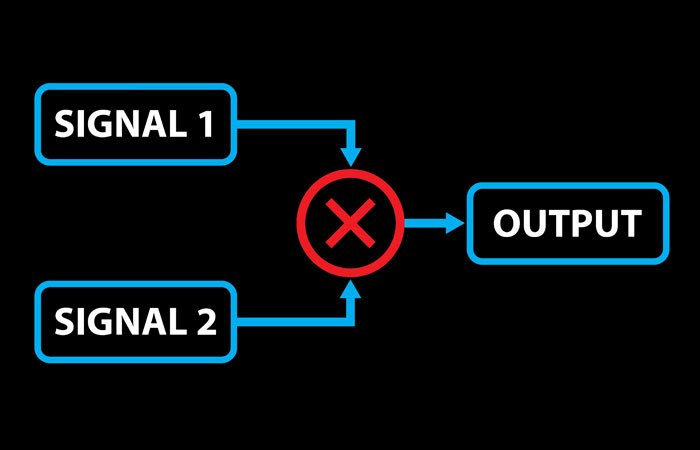
You’ve probably heard the distinct sounds of a ring modulator before. They tend to sound metallic or robotic, and sci-fi shows love to use them (“Exterminate!”). But what exactly do they do, how do they work, and where did the name come from?
A ring modulator multiplies two signals together to create two brand-new frequencies which are the sum and difference of the input frequencies.
What does all that mean, though? Ring modulation is similar to amplitude modulation, so let’s pick up where we left off with the voltage-controlled amplifier.
Your VCA lets one signal through when another signal is present. In effect it is multiplying the first signal by the second signal. If you’ve got full-CV going to the modulation input, then it lets the entire audio signal go through (as if multiplying it by 1). Cut the CV to 0 and you get zero signal out, because anything times zero equals zero. If you’ve got full CV, but nothing coming in the audio input, then the output is also zero (because 0 x anything = 0, remember?)
Ring Modulator
A ring modulator is basically a VCA with a special input. On a normal VCA, you want complete silence when there is no CV, so it won’t let any carrier signal pass when the modulation signal is 0 (or below). Negative modulation signals are just ignored (remember how we had to add a DC offset to the sine waves we connected to that input so they wouldn’t get clipped?). A ring modulator, on the other hand, passes the carrier when the modulation signal goes negative as well, but it inverts it (anything x a negative = negative anything).
This makes RM different than AM because it has the effect of cancelling the carrier frequency from the output signal, leaving only the sum and difference frequencies.
To help visualize all this, let’s run our two sine waves from the previous lesson through a ring modulator and see what the scope tells us about the output waves and frequencies:
You can see in the spectrum where the two sidebands are present just like with amplitude modulation, but the big carrier frequency spike that was in the middle is gone!
Note: Since a ring modulator multiplies two bipolar signals together, but neither of these signals come through to the output, it doesn’t really matter which signal you use as the carrier and which you use as the modulator; they are interchangeable.
Now you know the difference between AM and RM. Ring modulation is basically just suppressed-carrier AM.
In this and the previous lesson we used sine waves for all our scope examples because they only have one harmonic. If you use other waveforms in your AM or ring mod adventures, each harmonic contained in one wave gets multiplied by each harmonic in the other wave, creating multiple sidebands. This can make for some very lush sounds.
Ring Modulator Modules
A ring modulator is often a separate module designed to just do RM. Some of these just have two signal inputs, and some have built-in oscillators to use as a modulation signal to multiply with whatever audio you provide.
Some VCAs have both unbalanced and balanced inputs, so you can use them as either a standard VCA or a ring modulator. The VCA we looked at in the previous lesson is one such unit.
In addition to the standard CV input (MASTER CV IN) where you would connect your EG or whatever signal you were using to control volume, it provides a separate mod input (MOD IN) that allows you to do ring modulation. It also has another interesting feature; turning the MOD AMT control changes the amount and type of modulation, letting it morph from no mod, through AM, through RM, then back to AM with an inverted carrier. It’s fun to watch on a spectrum analyzer as the sidebands come in and the carrier drops out.
Why Is It Called a Ring Modulator
Finally, we get to the big question. The answer actually has to do with how schematics for early RM circuits looked. They had a ring of diodes that steered the incoming carrier signal and changed its polarity based on the polarity of the modulation signal.
Most modern modules use ICs and active components to multiply signals. They are less noisy and more efficient than the original circuits, but they aren’t technically ring modulators (no diode rings!) The name stuck, however, and is used to describe pretty much anything that does this effect.


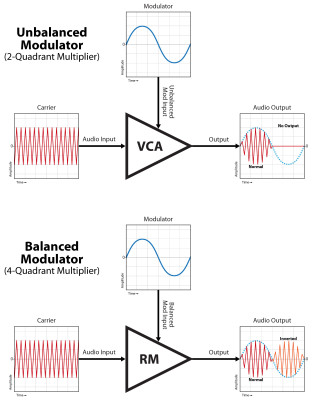
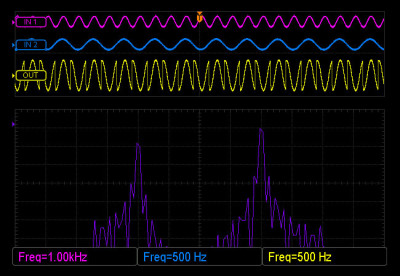
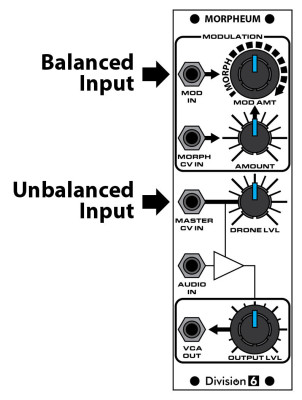
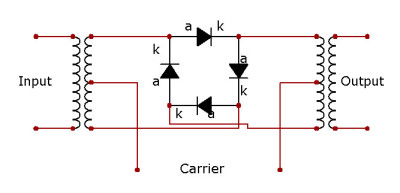










Thanks for creating this website, i love it. Good job, it’s very helpful and explains synthesis in a simple way.
Many thanks for creating all this, it’s been an excellent crash course so far, and I do hope you’ll keep at it, I’ll definately come back for more.
Muchas Gracias (Thanks a lot!) for creating this website. You’ve explained concepts that are helping me create sounds with a deeper understanding of what’s happening. Bravo !
I learned all that by applying but now I know what I was doing, it really improved my concepts! Thanks for this website
This is the first explaination I’ve encountered that is completely clear on the difference between Amplitude Modulation and Ring Modulation. I never realized that RM has the phase inversion that occurs when the carrier goes below zero. Thank you!